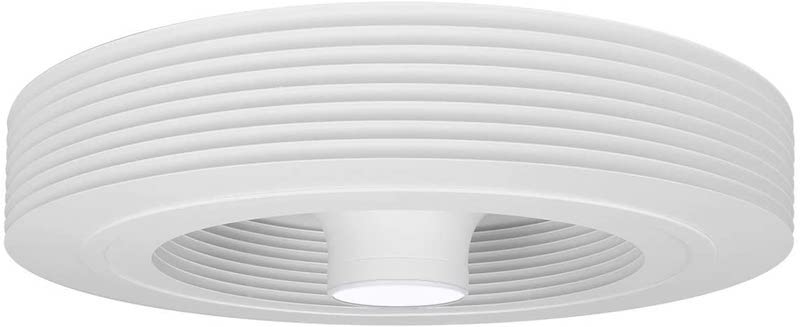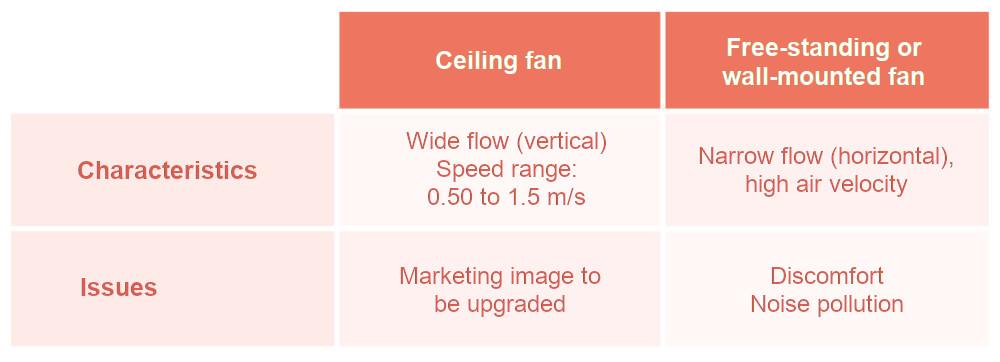From the Guide to Ceiling Fans published by BRISE, find a comparison between ceiling fans and air conditioning, followed by a comparison between fans and floor-standing fans.
1. Ceiling fan, air-conditioning version
Background and issues (extract from page 54 of the BRISE report)
In mainland France, particularly but not exclusively in the Mediterranean area, the penetration rate of ceiling fans is low, while air conditioning is developing very rapidly in the residential sector, following strong penetration in the tertiary sector.
Ceiling fans are still a very underdeveloped technology in these areas, even though they are even more relevant than in the French overseas departments, as they can replace air conditioning altogether, always in conjunction with a bioclimatic approach.
One notable advance in mainland France is the fact that the environmental regulations (RE2020) for new buildings take ceiling fans into account. This rapid development of air conditioning is largely due to the very strong growth in the penetration of heat pumps (PAC) for heating, which allow spaces to be air-conditioned in reversible mode. It is also due to the development of dual-flow CMVs, which are expanding rapidly in line with changes in regulations, allowing heat or cold to be blown through the ductwork using a heat pump. However, the air fan provides comfort at a lower environmental and economic cost, in tropical and equatorial climates, as well as in the warm season for temperate climates.

Energy and financial impact of a ceiling fan compared with air conditioning
Energy impact (yield)
Comparative energy efficiency: How ceiling fans beat air conditioning! (Extract from page 56 of the BRISE report)
It’s a scientifically indisputable fact: moving a mass of air (ceiling fan) requires much less energy than cooling it (air conditioning).
The Energy Effciency Ratio (EER) characterises the performance of a cooling system.
It is the ratio between the heat removed from the room and the electrical energy absorbed by the air-conditioning compressor to operate the thermodynamic cycle. It depends on indoor and outdoor conditions, which are standardised by certification bodies.
On the latest generation of A+++ class air conditioners, the European energy label also mentions a SEER (or seasonal EER), which indicates the average energy efficiency of an installation over a standardised season. Even the most efficient refrigeration units (class A+++) rarely provide more than a maximum of 4 kWh of useful cooling energy from 1 kWh of electrical energy input.
This nominal SEER remains a theoretical value, and campaigns to monitor installations show that if we want to characterise the energy service rendered per unit of energy absorbed, we should also take into account a ‘real SEER’:
- not only the energy absorbed by the compressor, but also by the other components that consume electricity: fans, regulation, etc.
- reduced efficiency due to clogging of the compressor, filters and other components, which can have a significant impact on the refrigeration energy produced.
- energy losses due to construction imperfections (insulation, etc.)
- reductions in energy efficiency linked to set temperatures in the premises to be cooled which are lower than the values used for standard measurements, and which can also lead to malfunctions linked to condensation phenomena, as well as damage to the walls of the premises.

We have estimated that these overall SEERs can vary, for recent installations of good quality, from values of 3.0 for A+ air conditioners, to 3.5 for A++ air conditioners and 4.5 for A+++ air conditioners.
The available data shows that typical consumption for these air conditioners leads to corresponding annual electricity consumption ranging from 47 kWh/(m2 -year) for A+++ units, to 60 kWh/(m2 . year) for A++ units and 70 kWh/(m2 -year) for A+ units, in various types of air-conditioned residential (bedrooms in homes) and commercial (offices) buildings, for operating times of 7 hours a day in spaces that are adequately protected from the sun and have relatively moderate internal heat gains.
In a bedroom, for a typical surface area of 12 m2 to be cooled, an efficient ceiling fan, carefully selected, correctly sized (1.50 m in diameter) and installed, can provide an equivalent energy service by lowering the temperature felt by the occupant by up to 4°C with a corresponding maximum consumption of :
- 10 kWh/(m2 . year) for an alternating current fan (power consumption 50 W)
- 4 kWh/(m2 . year) for a direct current fan (20 W power input) The comparative overall SEER values are given in the table below, which shows that fans (alternating current (AC) and direct current (DC) respectively) are between 7 and 16 times more efficient than class A+ air conditioners.

The seasonal energy efficiency of a ceiling fan is far superior (7 to 16 times more) to modern air conditioners (A+++).
The new generations of ceiling fans use DC motors. They offer 3 main advantages:
- They are highly energy-efficient, being around 3 times more efficient than AC motors (asynchronous motors) for comparable impacts;
- Their reliability and lifetime are important: unlike AC motors, they do not have a starting capacitor, which can be a source of failure;
- speed variation controls are facilitated by electronic voltage variation devices.
These DC motors (editor’s note: DC motors such as the SAMARAT & EXHALE) are set to become more widespread in ceiling fan applications, with controls generally with 6 speeds for domestic appliances.

Financial impact (economy) – Extract from page 52 of the BRISE report
Even a non-energy designer can calculate the energy and financial impact of a ceiling fan.
For example, for a 15m2 office in the West Indies or French Guiana fitted with a quality 28W DC ceiling fan running at high speed for 7 hours a day, 200 days a year, the electricity consumption will be 42 kWh/year. Specific consumption will be 2.8 kWh/year/m2.
This value should be compared with the consumption of an air conditioner, which in the West Indies would be more than 40 kWh/m2/year in a thermally well-designed building.
These values are pessimistic for the following reasons:
- the ceiling fan will not be in constant use every day;
- it will not always run at full speed. If it runs at low speed, consumption could be as low as 10 kWh/year and represent 0.7 kWh/m2/year.
The order of magnitude is a specific consumption of less than 1 kWh/m2/year. The corresponding expenditure for one kWh of electricity at €0.15/kWh will therefore be derisory and will be between €0.1 and €0.4/m2/year.
It should be possible to provide the client with these estimated costs, on a building scale, at the design stage, including a comparison with comfort solutions using air conditioning.
Obviously, operating and major maintenance costs would have to be added to this financial statement, but here too the frugal, robust technology of ceiling fans makes them particularly economical.
In conclusion, if these prescriptions are respected in a sensible architecture, the use of ceiling fans is clearly a high-quality, credible, sustainable and eco-responsible alternative to air conditioning, providing comfort at a much lower overall cost.
2. Ceiling fan VS floor fan
Why choose a ceiling fan rather than a floor fan – Page 44 of the BRISE report
Among the equipment most commonly used in buildings to create cooling are fans, generally free-standing and sometimes wall-mounted, with one-way or mobile flow.
Although this equipment, which is not attached to the building envelope, like other ‘plug-in’ devices, undoubtedly provides services in terms of summer comfort, with controlled investment and running costs, it also has a number of disadvantages associated with horizontal blowing.
These include the fairly high speed of the air flow and the creation of either ‘unvented’ zones (monodirectional flow), or alternately windy then unvented moments (oscillating flow). In addition, these fans sometimes have a mediocre acoustic level and can be perceived as dangerous because of the high rotation speed of the blades, due to their small diameter. Overall, these fans are less efficient than ceiling fans in terms of architectural durability.




